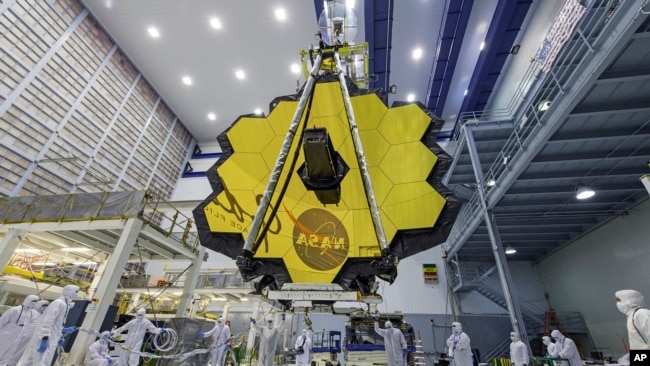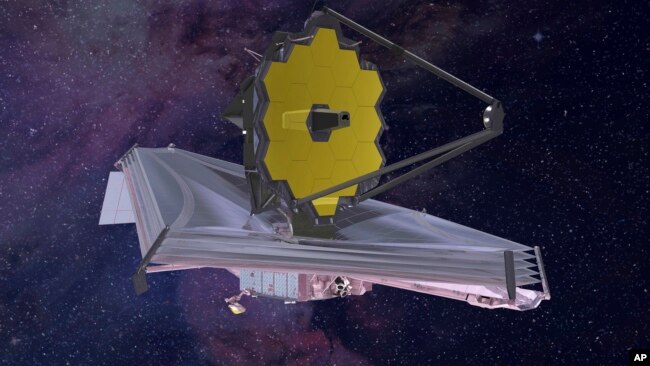85度からマイナス225度 の世界に対応する新型望遠鏡!
私たちに、どんな世界を届けてくれのでしょう!!
楽しみだワクワクが止まりません!!!
VOAで英語を学び、宇宙に思いを馳せましょう!!
NASAの強力な新型望遠鏡が周回軌道に到着(和訳)
NASA’s Powerful New Telescope Arrives at Orbiting Position
January 26, 2022
アメリカの宇宙機関NASAは、強力なジェームス・ウェッブ宇宙望遠鏡が太陽を周回する軌道の最終位置に到達したことを発表しました。
NASA は、James Webbジェームス・ウェブが月曜日にロケットのスラスタを約5分間噴射し、地球から約160万kmの位置に探査機を押し出したと発表しました。
NASAはジェームス・ウェッブについて、”これまでに作られた中で最大かつ最も強力な宇宙科学望遠鏡”と説明しています。過去の望遠鏡の発見に加え、宇宙の初期の発達についてのより詳細なデータを収集することを意図しています。
この軌道上の天文台は、約1カ月前にフランス領ギアナから打ち上げられました。その最終的な位置は、太陽と地球のラグランジュポイント、L2、と呼ばれる位置です。これは、太陽と地球の重力が釣り合うポイントです。これにより、太陽の周りを回る地球と望遠鏡が一直線に並ぶことになります。
望遠鏡を高温・低温に保つサンシールド
大きなサンシールドで、望遠鏡を高温側と低温側に分けています。一方は光と熱を取り込み、もう一方は遮蔽されて冷たいままです。
NASAの説明によると、望遠鏡の科学機器を搭載した側は、非常に遠くにある天体からの熱信号を求めるため、低温である必要があるそうです。その側は、摂氏零下225度程度で動作すると予想されています。
一方、高温側は−NASAによると摂氏約85度で動作するように設計されていて−望遠鏡の太陽光発電システム、通信機器、その他の機器を搭載しています。
サンシールドは、ジェームス・ウェッブの打ち上げから約1週間半後に無事開封されました。その数日後、天文台の7メートル近い鏡が展開されました。18個の部品からなる鏡は、望遠鏡が動作するまでにまだ完璧に位置合わせをする必要があります。NASAでは、その作業に約3カ月かかると見込んでいます。

In this April 13, 2017 photo provided by NASA, technicians lift the mirror of the James Webb Space Telescope using a crane at the Goddard Space Flight Center in Greenbelt, Md. (Laura Betz/NASA via AP)NASAが提供した2017年4月13日の写真では、技術者がメリーランド州グリーンベルトのゴダード宇宙飛行センターでクレーンを使ってジェームズ・ウェッブ宇宙望遠鏡の鏡を持ち上げている。(Laura Betz/NASA via AP)
新世代の望遠鏡
ジェームス・ウェッブは、人間の目では見ることのできない電磁波である赤外線を検出するために設計されています。この望遠鏡の機器は、遠くの天体を観測するために、ガスや塵を通して赤外線の波を見つけるために作られたものです。
赤外線検出システムと望遠鏡の科学機器は、効果的に機能するために十分に冷える必要があります。すべてがうまくいけば、NASAはジェームス・ウェッブが6月頃に最初の「初期リリース観測」を行う見込みであると述べています。
プロジェクトを率いるNASA関係者は、これまでの経過に満足しています。”ウェッブは正式に軌道に乗った”と観測所長のキース・パリッシュ氏は記者団に対し話しました。彼は、望遠鏡の軌道上での到着は、宇宙での”驚くべき30日間”を経た後だったと語っています。
ジェームズ・ウェッブは、ハッブル宇宙望遠鏡とスピッツァー宇宙望遠鏡に続くNASAの新世代望遠鏡と考えられています。ハッブルは30年以上前に打ち上げられ、スピッツァーは2003年に配備されました。どちらも数々の発見をもたらし、これまで以上に詳細で色鮮やかな宇宙画像を提供してくれました。
しかし、この新しい望遠鏡は、ビッグバン直後の約138億年前までさかのぼる宇宙の歴史のすべての時代について、科学者が学ぶのを助けることを目的としています。また、太陽以外の星を周回する惑星である太陽系外惑星を研究するための装置でもあります。
「私たちは宇宙の謎の解明に一歩近づきました」と、NASAのビル・ネルソン長官は声明で述べました。「そして、この夏、ウェッブが初めて見る宇宙の新しい景色を見るのが待ち遠しい」とも述べています。
NASA’s Powerful New Telescope Arrives at Orbiting Position
The American space agency NASA says its powerful James Webb Space Telescope has successfully reached its final position in orbit around the sun.
James Webb fired its rocket thrusters Monday for nearly five minutes to push the spacecraft into position about 1.6 million kilometers from Earth, NASA said in a statement.
The agency describes James Webb as “the largest and most powerful space science telescope ever built.” It is meant to add to the discoveries of past telescopes, while gathering more in-depth data on the early development of the universe.
The orbiting observatory launched from French Guiana about a month ago. Its final position is known as the second Sun-Earth Lagrange point, or L2. This is a point where the gravitational forces of the sun and Earth balance each other. This will permit the telescope to stay in line with Earth as it orbits the sun.
Sun shield to keep telescope hot and cold
A large sun shield separates the telescope into hot and cold sides. One side will take in light and heat, the other will be shielded and remain cold.
The side with the telescope’s science instruments needs to stay cold because it will be seeking heat signals from very distant objects, NASA explains. That side is expected to operate at about 225 degrees below zero Celsius.
The hot side – which NASA says is designed to operate at about 85 degrees Celsius – holds the telescope’s solar power system and communications and other equipment.
The sun shield successfully opened about a week and a half after James Webb launched. A few days later, the observatory’s nearly seven-meter mirror was deployed. The mirror, a collection of 18 different pieces, still needs to be perfectly aligned before the telescope can operate. NASA expects that process to take about three months.
New generation telescope
James Webb is designed to detect infrared waves – a kind of electromagnetic energy that cannot be seen with the human eye. The telescope’s instruments were built to find infrared waves through gas and dust in an effort to observe distant objects.
The infrared detection system and the telescope’s scientific instruments will need to get cold enough to perform effectively. If all goes well, NASA says it expects James Webb to produce its first “early release observations” sometime in June.
NASA officials leading the project have been pleased with how things have progressed so far. “Webb is officially on station,” Observatory Manager Keith Parrish told reporters. He said the telescope’s orbital arrival came after “a remarkable 30 days” in space.
James Webb is considered NASA’s new generation telescope after the Hubble and Spitzer space telescopes. Hubble was launched more than 30 years ago and Spitzer was deployed in 2003. Both of those telescopes led to numerous discoveries and provided more detailed, colorful space images than ever before.
But the new telescope aims to help scientists learn about all periods of the universe's history dating back to just after the Big Bang event, about 13.8 billion years ago. It is also designed to study exoplanets - planets that orbit stars other than the sun.
"We’re one step closer to uncovering the mysteries of the universe,” NASA Administrator Bill Nelson said in a statement. “And I can’t wait to see Webb’s first new views of the universe this summer,” he added.
Words in This Story
thruster – n. an engine that produces propulsion by releasing a jet of fluid or a stream of particles
shield – n. a piece of equipment that serves as a protective cover or barrier
align – v. to put things in an exact line or make them parallel
detect – v. to discover or notice something
remarkable – adj. very unusual or noticeable in a way that is admired
view – n. things that can be seen from a place

